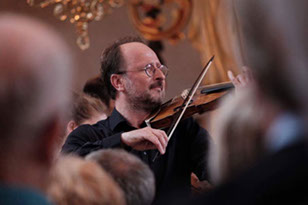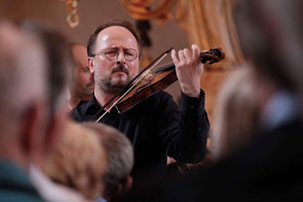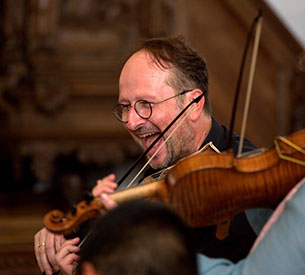To start with…
I am a violinist involved in early music. A baroque violinist. You know, historical performance practice – researching and reconstructing how music sounded then. In the baroque period. The correct way. The only way. The authentic way! I guess you’ll be yawning by now, with a growing urge to click away from these pages and skip my boring-narrow-nerdy authenticity chapter. Still, I will urge you to give me a chance. It has now been some time since I left the brigades of the baroque police. And my liberation from a conception of authenticity defined by the reconstruction and conservation of some kind of lost original, as well as my reflection on the paradoxes encountered on the way, will touch upon themes that might interest you.
So, to start with…
let me talk about authenticity. This term was used confidently in the early music environment of the 1970s and 80s with a frequency comparable to the use of the formal address ‘comrade’ in Eastern Europe during the totalitarian regimes. Authentic instruments, authentic performance, authentic you-name-it, thus became a trademark that enhanced the commercial value of the product (possibly inspired by the rise of the trend of labelling and distinguishing products on the market as ‘ecological’) and manifested an air of ‘chosen-ness’ in HIP performers (with a confident self-assured countenance reminiscent of certain religious fundamentalists).
And yes, you are guessing right: I was born and grew up in Czechoslovakia, in Eastern Europe, in the 70s and 80s (I moved to Sweden in 1989). So, the somewhat far-fetched association between the terms authenticity and comrade arises from my own experiences and recollections. The implementation of rules in a totalitarian system rings a bell of normativity similar to the quest for re-implementing the rules of the one-and-only true historically informed performance.
Remembering,
as a matter of fact, will open an important line of thought throughout this thesis. Remembering implies having been there. Having been there entitles one to the agency of an insider (especially in the sense of coming from there). But by being here and now (Sweden), outside of my own idiomatic former here (Slovakia), enables me to see my former here as present there (Slovakia), a distance necessary for reflection and re-evaluation of the past, while being in a parallel process of assimilation of the former there, which has now become my present here (Sweden).
This rather equilibristic exercise in (t)hereness might serve as a useful background for reflection on the influence of cultural and political circumstances on my identity, or, in accordance with Stuart Hall, the process of identification (Hall, 1996). By setting the identity ‘on the move’ as identification, and giving up the tempting stability of a static term for the unpredictability of a process, every outspoken articulation of authenticity will appear only temporally, as a trace of a provisory ‘has-been’ (or hopeful ‘might-have-been’), rather than capturing the unequivocal authentic ‘now’.
In fact, history does not belong to us; we belong to it. Long before we understand ourselves through the process of self-examination, we understand ourselves in a self-evident way in the family, society, and state in which we live. The focus of subjectivity is a distorting mirror. That is why the prejudices of the individual, far more than his judgments, constitute the historical reality of his being (Gadamer, 2004, p. 278).
In a specular relation of the self and the environment, the self does not necessarily own its choices. The share of the agency of (free) choice between the self and the circumstantial environment is, at least, blurred, if not ever-fleeting and contingent. Existential being in the world constitutes the essence, not vice versa. The ‘definitive’ identity thus might seem to be achieved only at the final destination, which is non-existence. But termination of an active agency of the subject does not automatically deactivate the interests of the surrounding discourse(s). Thus, even the final destination loses the attribute of finality and the apparent final essence is postponed in a chain of substitutions, representations, interpretations, and performances. 'Identities are thus points of temporary attachment to the subject positions which discursive practices construct for us'. (Hall, 1996, p. 6)
My career-choices, even those appearing to be purely musical and aesthetical, will at a closer look reveal an implication in, or even an addiction to, a game enacted on the vague intersection of personal and public. Of the self and the world.
Identification is, then, a process of articulation, a suturing, an over-determination not a subsumption. There is always 'too much' or 'too little' – an over-determination or a lack, but never a proper fit, a totality. Like all signifying practices, it is subject to the 'play', of différance. (Hall, 1996, p. 4)
Well, moving between different political systems while playing the violin may seem like the perfect example of escapism. Is there any traceable continuity, any recognizable self or identity, as a source and condition of authenticity? Or, to put the the question another way: in all of these turmoils and storms, has my playing (the how) changed? Possibly. Has my musical story (the what) changed? Apparently. Has the meaning of my playing (the why) changed? For sure! But there is something that remains. My tune. I know my tune, in spite of the unexpected turns, losses, and sacrifices. My tune lives in the ephemeral realm, in the game of temptation and evasion; the play between what-how-why evokes a resonance of promise, an eternal postponement, as the only graspable reality. By playing my tune here for you, from the beginning again, as I remember it, I can provide an interesting counterpoint to the discussion of authenticity and related questions of identity, the self, and subjectivity.
So, to start with, I am a violinist… now (also) expressing myself through words. My tune can then be translated as my story.
Writing – a musician at a (different kind of) keyboard
But, how do I strike the right key? How do I find the efficiency of flowing harmonies and beautiful melodic lines on a keyboard filled with letters? Being used to articulating my identity through music, is the writing – using words instead of musical sounds – a new process of identification? The best answer to these questions, in my mind, is another question: Can one ever live outside of language? Language must have ‘happened’ to us suddenly, in an instant, in an acute need to tell a story.
The myriad of events in life need sorting and selecting (done retrospectively), in order to create a coherent design of a ‘story’. A story that one constantly tells and re-tells in the course of life. In the action of telling, we live and re-live our story again and again. At some point we attain such skills in shaping it, that we can hardly differentiate between the actual events and the resulting story. It might seem that the story is shaping, or even generating, the actual events. The story itself thus becomes our life. 'In the end, we become the autobiographical narratives by which we "tell about" our lives' (Brunner, 2004, p. 694).
The authentic articulation of identity in a story is situated in, and assessed through, the interplay with the other stories in a community; rather than through a pedantic confrontation with, and a continual reinterpretation of, the actual events. The stories are enlivened in a relation with other stories, in an intensifying spiral of intertextual games, moving away from a trivial authorship towards a shared readership, from the insignificant silence of the event into the resonance of communication. The identity, and its authenticity, is thus constructed in a story, when the actual events are performed in the context of other performances. The process of identification is thus choreographed in a context of voices, gestures, harmony, and the temporal relations of the environment that I found myself in.
'Kde bolo tam bolo…' these words emerge from the furthest periphery of my memory. As they probably do for most of you, in your own languages. The phrase with which every fairy-tale would start: 'Once upon a time…' Exciting and exotic, inviting me to something unreal and far away… But then, when those words were uttered, without really noticing when and how, as if by magic, I was immersed, through these caressing words, straight into a story. I wonder if this transcendental ‘move’, becoming absorbed by language through a story, should be called getting lost, or, actually, the opposite: being found…
The genesis of a violinist: Sound, Movement, Word
In the Beginning there was… Sound. Well, that’s what I was told as a 6-year-old violin adept. And of course, as a disciplined and trusting student, I took Sound to be a synonym of Music. Over the years, the Sound would come more and more efficiently out of my violin, as prescribed by my Teacher.
Many evenings, at home, when ‘serious’ practicing was (finally) done, my brother would drop in with an accordion, my father would sit down at the piano or pick up a guitar (with the upper string often missing), and before long my mother would join us singing. This was why I loved the violin! This was my reward for tedious etudes and scales! Folk dances and songs filled the room. Familiar rhythms invaded my body and I would embrace the violin – a former stranger – as if it were my dance partner; and so I found Movement.
My mother’s timeless songs, always resounding in my ears, guided my bow, which seemed to float naturally on the waves of her voice, reading her lips, imprinting the shapes and accentuations – and so I found Word.
I believed that this double life – the secret joys of folk music at home, while surviving tedious lessons and practising the ‘real stuff’ – was going to be my destiny. But suddenly, one day, unexpectedly, during a lesson, in a moment of neglected vigilance, the most terrible thing happened: Word and Movement exploded out of my violin in the middle of my etude! Shocked, I attempted to apologize, '…so sorry, professor…' and 'What? What was That!?' and terrified 'just… a mistake... sorry' and, actually, not so angry: 'Do it again!' and unbelievingly 'I beg your pardon…?' and, was he really smiling? 'That was it!' yes, big smile: 'Great!! do it again, just like That!'
And so I found a new beginning: Word and Movement. Growing up in Czechoslovakia in the 1980s, the disruption of the wall in the realm of violin playing between the learned and the playful, was one of the first in a series of significant liberations: some borders were soon going to be dissolved and another wall was just about to fall…
Finding (my) voice
As I once strived to find my sound on the violin, so I am now finding my voice in writing. But even in words, I don’t want to lose the music. Let me drum the rhythms of the emerging ideas, bathe in the resonance of the images, accent the dissonance of contrasts and paradoxes, and build the striking dynamics of my story! I know… there is a fine line between a rich metaphor and an empty cliché. But as in the beginning with the violin, calibration takes time. Still, I bet you would rather hear my bombastic metaphors, than the first sounds that I made on a violin!
Football pro – (con)sequences
Twenty-two boys, on a green field marked with white lines, running after a round object which they are trying to kick into a netted box: this phenomenon may seem to have very little to do with violin playing.
A boy alone in a room, holding a hollow wooden box under his chin, making noises by drawing strands of horsehair attached to a long stick across the strings: this would equally seem to have very little to do with football.
Football and violin were the two realms in which I learned to ‘see’, ‘hear’ and ‘feel’; two ways of finding myself in the world; two ‘languages’ I exercised in order to express myself. On the surface, I tried to keep these two worlds apart. I used to hide my violin behind the boxes of football shoes during football practice, and hide my training bag behind the piano during a violin lesson, and tired of being called 'Paganini' among footballers and 'Pelè' among my violin pals.
I was perfectly at ease in both of these worlds, being one-hundred-percent footballer in the afternoons – talking the necessary ‘tough language’ – while mornings and evenings were devoted to violin practice, concerts, and lively and (attempting-to-be) intellectual after-concert debates with colleagues.
When I was seventeen, an increase of intensity and demands in both fields forced me to make a difficult choice. In the end I turned down the invitation of the Slovak junior national football team and enrolled in the Music Conservatory in Bratislava.
The body in time and space – analogy of music performance and sports
Yes, true, I agree! Football and violin, as they appear to onlookers, have not much in common. But I never looked at it from the outside. I was entirely ‘in’ these two worlds. The very same body and its faculties were involved in practical solutions, both in my practice room as on the grass field.
A comparison of daily practising routines in football and the violin might reveal a great deal of similarity in the ways the body is involved in the process of refining and automatizing technical skills. An approaching ball can be processed by anticipated ‘incorporation’, which is more than just coordination. The speed and direction of the ball is felt in the body before the touch.
Drilling exercises with a ball belonged to the same category of activities as practicing scales, trills, and bowing. While repeating the movements over and over, both mistakes and success served to attune the body.
I still remember two obvious mistakes in football; if I am too late in the approach, the ball bounces on the grass a meter ahead of me and over my head; or, if the approach is too fast, I run under the ball without reaching it. In violin playing, shifting position and not reaching it, or overshooting, causes a comparable embarrassment. But that is how one learns…
Another interesting analogy is the touch between the body and external objects: using the springiness and elasticity of the string and bow, as well as that of a ball. Eventually, the body will incorporate these external dimensions as an internal property of bodily skills. An instrument, or a ball, becomes a part of the body, with all its physical properties, and thus the expression (or efficiency in football) of the body is enhanced.
It’s (just) a game
Both in violin playing and football, all preparations aim at acquiring a state of ‘readiness’ to deal with live situations. The knowledge and skills, the what we learn on the way, is not in itself a guarantee that we have achieved ‘readiness’.
This readiness is not the accumulated information. Knowledge and skills make the readiness possible. But they cannot replace it. Readiness is a transcending ability to ‘use’ the accumulated/embodied skills and knowledge here and now, in the present moment, in the situation.
If footballers had their Gadamer, he might have described a player’s ability to score in every match by some kind of bildung, tact, or common sense. The whistle starting a football match, just as the applause welcoming the artist on stage, are similar in marking the beginning, when, under the scrutiny of the audience, and, in accordance with a certain body of rules, the game begins to ‘happen’.
During an approximately similar time frame of 90 minutes, players (those kicking, as well as those making sounds) engage in tackling the emerging situations. They use their state of ‘readiness’ to direct and coordinate their knowledge and skills. They distribute their powers according to the relevance and urgency of the occurring events.
This ‘readiness’ cannot be achieved in any other way than in action, by playing concerts/matches. Both sportsmen and musicians are in ‘good shape’ not (only) by the amount of training and practicing, but by the regularity of being in the game.
...is comprised of some auto-ethnographic texts that are relevant to my research project.
This section...


